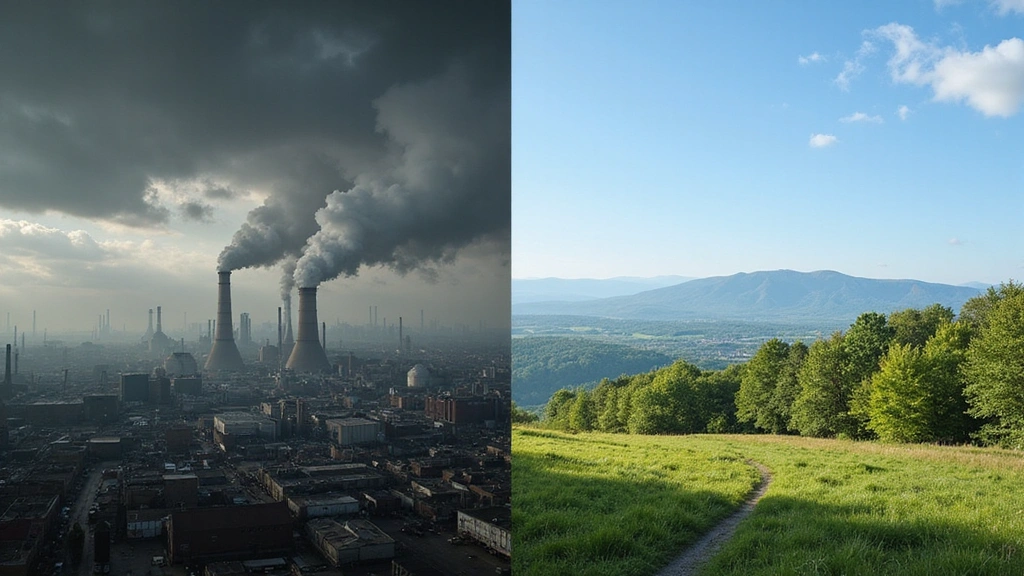The Industrial Revolution marked a turning point in history, introducing incredible innovations that transformed societies and economies.
However, beneath the surface of progress lay a series of environmental challenges that often go unnoticed. From rising pollution levels to the devastating effects on natural habitats, the true cost of industrial advancement is significant. In this visually captivating listicle, we will uncover eight surprising environmental impacts of the Industrial Revolution that are often overlooked. Prepare to be informed and inspired to reflect on our current environmental practices!
Imagine a collage of dark, smoky factories belching thick clouds of soot into the sky, juxtaposed with the stark beauty of a natural landscape slowly being consumed by urban sprawl. This image could be framed in grey and dark greens, symbolizing pollution, with vivid colors fading into the background, representing the loss of the environment.
Contents
- 1. Air Pollution: The Silent Killer
- 2. Water Pollution: The Forgotten Crisis
- 3. Deforestation: The Price of Progress
- 4. Soil Degradation: The Hidden Threat
- 5. Industrial Waste: A Growing Concern
- 6. Climate Change: The Inevitable Impact
- 7. Loss of Biodiversity: The Unseen Cost
- 8. Urban Heat Islands: The Rising Temperatures
1. Air Pollution: The Silent Killer

Air pollution experienced a dramatic increase during the Industrial Revolution as factories and coal-burning power plants discharged enormous quantities of smoke and toxic gases into the atmosphere. This dense smog not only blocked sunlight but also posed significant health risks to workers and local residents. Cities such as London became notorious for their ‘pea soup fog’—a hazardous blend of smoke and fog that resulted in respiratory illnesses and various other health complications.
The repercussions of air pollution extended beyond immediate effects, leading to long-lasting environmental harm that impacted both plant and wildlife in surrounding regions. Unique insights into this issue reveal that many of the pollutants released during this era continue to linger in the environment today, adversely affecting air quality and contributing to climate change.
In light of these historical challenges, modern cities are now turning to technology to address air pollution, learning valuable lessons from the past. To take action, consider investing in air quality monitors to keep track of pollution levels in your area, or support your respiratory health with respiratory health supplements.
Additionally, you can explore eco-friendly transportation options to reduce your carbon footprint and advocate for greener industrial practices. For a deeper understanding of air pollution and its effects, consider reading insightful books on air pollution. By acknowledging the roots of air pollution, we can strive for a healthier environment for future generations.
2. Water Pollution: The Forgotten Crisis

With the rise of industries came the alarming practice of dumping waste into rivers and lakes. During the Industrial Revolution, factories discharged harmful chemicals and untreated sewage directly into water bodies, resulting in severe water pollution. This catastrophic shift not only devastated aquatic life but also contaminated drinking water sources, leading to widespread diseases among local populations. Rivers that were once vibrant ecosystems, teeming with fish, became toxic and lifeless, triggering long-term consequences that have led to a decline in biodiversity and a shift in ecosystems that we are still struggling to recover from today.
In response to this ongoing crisis, many cities are now investing in advanced water purification systems and implementing stricter regulations to prevent history from repeating itself. Community clean-up initiatives and awareness campaigns play a vital role in restoring our water bodies, and equipping volunteers with river cleanup kits can significantly enhance these efforts. Additionally, educating ourselves about sustainability through books on water conservation and opting for eco-friendly cleaning products can contribute to a healthier environment.
Visualize the alarming scene of a once-clear river now murky and dark, with industrial waste flowing into it. Surrounding the river are dead fish and polluted banks, starkly contrasting with a hopeful vision of community members coming together to clean up the area and restore its natural beauty.
3. Deforestation: The Price of Progress

As industrial activities surged, vast expanses of forests were devastated to accommodate factories, railroads, and urban sprawl. This widespread deforestation brought about severe repercussions, such as the loss of biodiversity and a notable increase in carbon emissions. Forests are crucial for absorbing CO2, and their destruction played a significant role in exacerbating climate change. The Industrial Revolution initiated a critical imbalance in our ecosystem, resulting in soil erosion and the disruption of habitats for countless species.
Today, we are beginning to appreciate the importance of reforestation and sustainable land practices. To actively engage in restoring our planet’s green cover, consider exploring tree planting kits that can empower you to plant trees in your own community. Additionally, reading deforestation awareness books can deepen your understanding of this pressing issue and inspire you to take action. You might also think about contributing to reforestation projects that aim to restore ecosystems affected by industrial expansion.
Visualize a once-thriving forest now reduced to mere stumps and barren land, with a few struggling trees valiantly standing in the foreground while industrial buildings loom in the background, a stark reminder of the encroachment of industry on nature. By supporting urban green spaces and conservation efforts, such as community gardens and tree planting initiatives, individuals can play a vital role in healing our planet.
4. Soil Degradation: The Hidden Threat

The Industrial Revolution ushered in an era of intensive farming practices and the widespread use of chemical fertilizers. While these methods initially increased agricultural productivity, they have also led to severe soil degradation. Over time, such practices have depleted essential nutrients from the soil, rendering it less fertile and increasingly vulnerable to erosion. This degradation poses significant long-term risks to food security and agricultural sustainability, with the overuse of chemicals also contaminating groundwater supplies, thereby threatening human health and local ecosystems.
Fortunately, unique insights reveal that regenerative agriculture practices are gaining popularity as effective solutions to restore soil health. Farmers are now embracing techniques like crop rotation, the use of organic fertilizers, and reduced tillage methods to rejuvenate depleted soils and promote a more sustainable approach to farming.
To further educate yourself on this crucial topic, consider investing in soil health guides or exploring insightful literature on regenerative agriculture. Additionally, if you are looking to support sustainable practices, check out sustainable farming tools that can help in promoting healthier agricultural methods.
Imagine a cracked, dry field where crops struggle to survive, with a distant tractor applying harmful chemicals. In the foreground, a concerned farmer examines the soil, representing the urgent need for change in our agricultural practices. By supporting local farms that prioritize sustainable agriculture and educating ourselves about soil health, we can contribute to a healthier food system for future generations.
5. Industrial Waste: A Growing Concern

The factories that emerged during the Industrial Revolution not only churned out goods but also generated staggering amounts of waste. This waste, which ranged from hazardous chemicals to solid refuse, often found its way into landfills or was carelessly dumped into nearby water bodies, leading to significant environmental degradation.
The consequences of this industrial waste extend far beyond pollution; communities situated near these waste sites faced severe health risks, with many areas still grappling with the long-term impact of contamination that necessitates extensive cleanup efforts.
Innovations in waste management and recycling technologies are crucial in tackling this pressing issue. For those looking to make a difference, consider investing in waste management guides that provide insights on reducing waste production. Additionally, utilizing recycling bins can encourage better sorting and repurposing of materials, promoting a circular economy.
For a deeper understanding of sustainable practices, explore books on sustainable manufacturing that highlight innovative methods to minimize waste. Moreover, switching to eco-friendly packaging solutions can significantly reduce the environmental impact of industrial processes.
Visualize a sprawling landfill, overflowing with discarded industrial materials, while a nearby community struggles to cope with the dire consequences. This image serves as a poignant reminder of the urgency for better waste management practices and the importance of supporting companies dedicated to sustainability.
6. Climate Change: The Inevitable Impact

The Industrial Revolution is frequently recognized as a pivotal force behind climate change. The heavy dependence on fossil fuels for energy production resulted in a dramatic surge in greenhouse gas emissions, which in turn has significantly accelerated global warming.
This escalating crisis has led to a range of dire consequences, including extreme weather events, rising sea levels, and disruptions to ecosystems across the globe. Reflecting on this period, it’s clear that the groundwork for our current climate emergency was established during this transformative era. To gain a deeper understanding and take informed action, consider exploring eco-friendly lifestyle guides, which can help you adopt sustainable habits.
Visualize the urgency of our situation: imagine a melting glacier with dark smoke billowing from industrial activity in the background. This stark contrast between the beautiful yet vulnerable natural landscape and the harsh realities of climate change underscores our shared responsibility to act. Supporting renewable energy initiatives through products like renewable energy products, utilizing carbon footprint calculators, and reading books on climate change can empower you to make a difference.
Together, we must confront the challenges posed by climate change through collective action from individuals, businesses, and governments alike.
7. Loss of Biodiversity: The Unseen Cost

The rapid expansion of industries and urban areas during the Industrial Revolution has led to significant habitat destruction, resulting in a dramatic decline in biodiversity. As natural habitats were transformed into factories and sprawling urban landscapes, countless species faced the threat of extinction. This loss of biodiversity carries profound implications, disrupting ecosystems and weakening their resilience to environmental changes.
Unique insights show that the extinction of even a single species can trigger a cascade of effects throughout the food web, impacting various other species and the essential ecosystem services they provide. To truly grasp this impact, envision a barren landscape where vibrant wildlife once thrived, starkly illustrating the consequences of industrial growth on biodiversity.
To help combat this issue, consider supporting wildlife conservation efforts by exploring wildlife conservation books that offer valuable insights into protecting our planet’s species. You can also make a difference by using habitat restoration kits to aid in the recovery of damaged environments. Additionally, incorporating eco-friendly products into your daily life can help reduce your ecological footprint. Lastly, consider making a meaningful contribution by donating to conservation organizations dedicated to protecting natural habitats. Every small action can lead to a more biodiverse and thriving planet for future generations.
8. Urban Heat Islands: The Rising Temperatures

The rapid urbanization that accompanied the Industrial Revolution has led to the emergence of urban heat islands, where city areas experience significantly higher temperatures than their rural counterparts. This phenomenon is largely due to the widespread use of materials like concrete and asphalt, which absorb and retain heat, resulting in increased energy demands for cooling.
During heat waves, these elevated temperatures can exacerbate health issues, making it crucial to find effective solutions. Innovative urban planning and the incorporation of green infrastructure, such as parks, green roofs, and trees, can play a pivotal role in combating these heat effects.
Consider investing in urban gardening kits to create green spaces in your community. Additionally, explore green architecture books to learn more about sustainable design practices. For those looking to enhance their outdoor spaces, using eco-friendly landscaping tools can make a significant difference. Lastly, consider supporting local initiatives by making donations to urban greening projects that aim to reduce the impacts of urban heat. Together, we can foster a healthier urban environment.
Conclusion: Reflecting on the Past for a Sustainable Future

The Industrial Revolution brought about significant advancements, but it also left behind a legacy of environmental challenges that we must confront.
By understanding the impacts of this historical period, we can make informed choices today to protect our planet. As we move forward, embracing sustainable practices and advocating for environmental protection is crucial. Let’s learn from the past to create a healthier, greener future for generations to come!
To visualize this conclusion, imagine a hopeful scene of people planting trees in a community park, surrounded by greenery and a clear sky. This image should evoke a sense of optimism and collective responsibility towards environmental stewardship.
Note: We aim to provide accurate product links, but some may occasionally expire or become unavailable. If this happens, please search directly on Amazon for the product or a suitable alternative.
This post contains Amazon affiliate links, meaning I may earn a small commission if you purchase through my links, at no extra cost to you.




